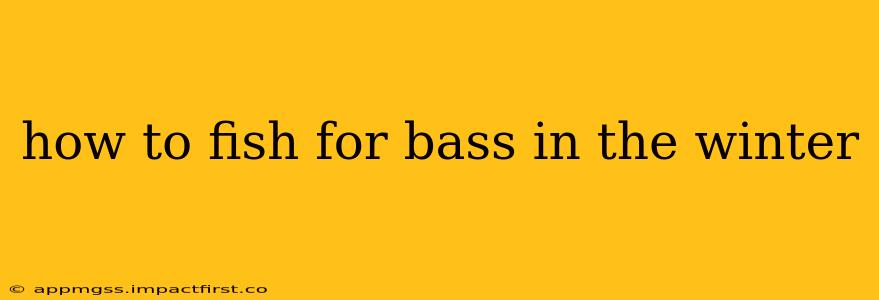Winter bass fishing presents a unique challenge, demanding patience, precision, and a shift in strategy from warmer months. The colder temperatures drastically alter bass behavior, requiring anglers to adapt their techniques and locations to find success. This comprehensive guide will explore effective winter bass fishing strategies, addressing common questions and concerns.
Where to Find Bass in Winter?
Bass seek refuge in deeper, warmer water during winter. Their metabolism slows, requiring less frequent feeding. Focus your search on these key areas:
- Deeper Water: Look for areas with depths of 15-30 feet or more. Points, creek channels, and submerged humps are excellent starting points.
- Warm Water Discharge: Power plants, industrial outflows, and natural springs can create localized areas of warmer water, attracting bass.
- Overhanging Structures: Docks, trees, and brush piles provide cover and thermal protection for bass. Concentrate on the deeper sections of these structures.
- Main Lake Points: These points extend into deeper water and often hold baitfish, making them prime spots for winter bass.
What Baits Work Best for Winter Bass?
Winter bass are less active, demanding slower presentations and smaller, more enticing baits:
- Slow-Sinking Crankbaits: These mimic injured baitfish, triggering a reactive strike. Choose smaller sizes and natural colors.
- Jigging Spoons: These versatile lures can be retrieved slowly or allowed to flutter to the bottom, enticing bass with their subtle movement.
- Texas-Rigged Worms or Senkos: These soft plastics offer a natural presentation that's perfect for slower winter fishing. Choose darker colors like green pumpkin or black.
- Drop-Shot Rigs: This technique allows precise bait placement in the bass's strike zone, especially effective around deeper structures.
- Small Spinnerbaits: A slow retrieve with a small spinnerbait can be effective in areas with some current.
What is the Best Time of Day to Fish for Bass in Winter?
While bass are active throughout the day in winter, the warmest parts of the day generally produce better results. Focus on:
- Midday: The sun's warmth can slightly raise water temperatures, increasing bass activity.
- Sunny Days: Sunny days tend to be more productive than cloudy or overcast days, as the sun's warmth penetrates deeper into the water.
What Gear Do I Need for Winter Bass Fishing?
Winter bass fishing requires specialized gear:
- Heavy Line: Use heavier line (12-17 lb test) for better sensitivity and to help with setting hooks in lethargic bass.
- Sensitive Rods: A sensitive rod allows you to detect subtle bites and set the hook effectively.
- Warm Clothing: Winter fishing can be cold, so dress warmly in layers. Consider hand and foot warmers.
How to Improve My Winter Bass Fishing?
- Patience is Key: Winter bass fishing requires patience. Don't expect consistent action. Spend time meticulously searching for bass in their preferred winter habitats.
- Slow and Steady: Use slow retrieves and subtle presentations. Avoid overly aggressive techniques that might scare off inactive bass.
- Vary Your Techniques: Experiment with different baits and retrieve techniques to find what works best on a given day.
- Pay Attention to Water Temperature: Use a water temperature thermometer to identify the warmest areas.
- Observe Your Surroundings: Look for signs of baitfish activity or other indicators of bass presence.
What are some common mistakes when winter bass fishing?
- Fishing too aggressively: Winter bass are sluggish, so overly aggressive retrieves will often turn them off.
- Not focusing on deeper water: Bass move to deeper, warmer water in the winter; concentrating on shallow areas will likely prove fruitless.
- Using the wrong bait: Smaller, slower-moving baits are more effective in colder water.
- Lack of patience: Winter bass fishing requires significant patience, and consistent effort is key.
By understanding bass behavior in winter and employing the strategies outlined above, you can significantly improve your chances of success on the water, even during the colder months. Remember to always practice responsible angling techniques and adhere to local fishing regulations.
